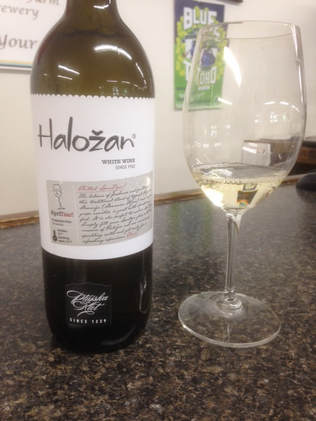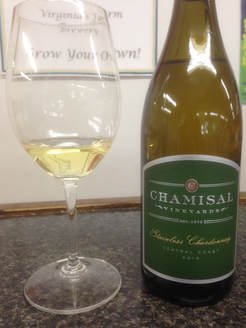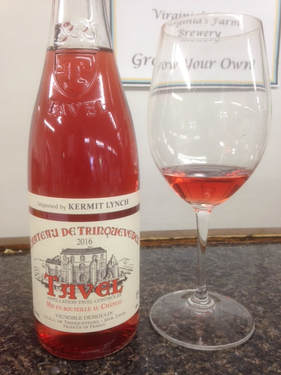 This wine can be thought of as a solution that's been waiting for the right problem for it to solve. Slovenia actually has a fairly long history of making quality wine, especially the region along the border of Italy, but was cut off from the Friulian culture after World War II. Post Communism, Slovenia is one of the few nations to have port access to the Adriatic and Mediterranean shipping lanes, so their wines have had a much easier time returning to the market than others. Their traditional wines are built to be very light, clean and naturally fermented with little industrialized influences, but for a large part of the last 20 years or so have gone unnoticed as a large part of the international market has leaned towards 'size' and 'intensity'. The pendulum has started to swing back in the other direction in recent years, but many of the new convert wines coming out can run quite pricey for the experience. (Cue drum-roll) Enter Slovenia! Above all else, wines like this represent the most pleasure for the dollar for those that enjoy the style. Made from primarily a blend of Welschriesling and Furmint with a smattering of other grapes in the mix, the pale straw color and low abv on the label (12%) may at first indicate a thin or mild wine. The first aromas are no weak sauce however, with lots of apple and green grapes, a touch of orange flowers from the Muscat in the blend, and a hint of the 'natural yeast salinity. The palate is equally fresh and bright, surprisingly filling in the mouth with lots of grapeskin tannin and crisp apple tones on the finish to leave your mouth refreshed and quickly wanting another sip. Right out of the fridge, the zesty side of the wine is much more prominent, but as it warms more of the flowery subtle perfumes and juicy lime tones come out. This is a wine that will become a must-have in your fridge for impromptu mid-week meals and enjoying with friends.
1 Comment
 Many people consider 'unoaked Chardonnay' a four letter word. It's understandable in many way, as the fruit used in a lot of unoaked wines was the lowest quality that wouldn't hold up to any time in barrel. Over the years the quality of grape growing has improved, providing better and better raw material for the wineries, and the ability to raise the level of their unoaked wine game has improved as well. Examples like this will still see some of the malolactic fermentation which provides the buttery tones and soften some of the acidity, but the natural richness of the fruit doesn't need to be bolstered by aging it in oak. The first aromas are creamy lemon curd and hints of tropical white fruits, citrusy but not harsh or austere, more like walking through the produce section of the grocery store with fresh samples cut. Round melon and white fruits abound on the palate, with just a touch of apple and citrus on the palate to cut through on the palate and provide some freshness. This doesn't need the oak, you won't miss it at all, and it will be a perfect everyday food and cocktail option.  Sancerre is best known by far for the production of Sauvignon Blanc over Pinot Noir, so much so that many would be surprised that as much as 20% of the region is planted to Pinot Noir (thinking that number would seem quite high). In truth, the second most compelling wine from Sancerre is usually the Rose based on Pinot Noir more-so than the reds. So to find a full blooded Pinot Noir from Sancerre that is not only quite good but an excellent value is stunning, especially as most consumers continue to fight the battle of finding Bourgogne styled Pinots without spending Bourgogne prices. Blended with some fruit from just outside the appellation keeps this wine from being called a Sancerre Rouge, but the minerality behind the fruit is indication of where it's from. A nice dark color for a Pinot Noir and it shows off nice darker cherry tones and red fruits on the nose. The chalky minerality give the palate a bit of a stronger tannin feel at first but evolves into something softer and quite elegant, keeping the dark fruits on the nose polished and pleasing on the palate. Fans of the French style of Pinot Noir should be all over giving this a try.  As the school season looms on the horizon for parents, students and teachers alike, we can still steal a bit more Summer in our glass with a classic Rose from Tavel. Despite being surrounded by famous red wine regions like Chateauneuf-du-Pape and Lirac, Tavel is the only AOC in the Rhone that is 100% dedicated to making Rose since it was established in 1936. Not coincidentally, that was the same year this family owned estate was established, making them particularly influential, as well as being one of the longest standing producers in the Kermit Lynch Imports portfolio. This is a Rose that has been influencing generations of wine drinkers, long before Bradgelina or Drew Barrymore caught wind of it and made it hip, and continues to make one of the best versions you can find for the money. While some Rhone and Provence Roses are made from lesser quality or younger vine sites, Trinquevedel has very well established vines in some of the choicest soils of Tavel, allowing the flesh and character to show through. Though it is fairly ruby colored in the glass, this isn't heavy on Grenache as one would expect from Rhone Rose, which would make for a lower acid wine with lots of soft cherry tones. Tavel allows a maximum of 60%, but this bottling is a fairly broad blend that includes Cinsault, Mourvedre and Syrah as well as the white grape Clairette. The nose is cool strawberry with hints of Provence herbs and refreshing white fruits, and an impressively full texture on the palate that is both rich and vibrant at the same time, providing a long lingering finish of dried fruit skins. A great wine with Mediterranean seafood dishes, cool soups, and backyard sipping.  Patricia Green is one of the most influential winemakers in Oregon, having been involved in the industry since the late 80s, and one of the first female winemakers in the state when she took over her first vintage in 1992. Since breaking out and establishing her own label along with business partner Jim Anderson, the Patty Green label has been a consistent source of quality with their excellent variety of vineyard designated Pinot Noirs. White wines have been less of a focus, as the white wine scene in Oregon has been more Quixotic over the years. Pinos Gris is one of the more popular grapes there, but most of the plantings are made for wines that are a bit more basic than what the winery is looking for. The Chardonnay scene is improving as more wineries are moving to use the right clones in the right places, but there still aren't nearly as many quality sources for Chardonnay as there are for Pinot Noir. The one grape variety they have worked with consistently has been Sauvignon Blanc, which they were among the first to plant on their estate vineyard in 2000. In the time since they have encouraged other sites to plant the grape and have found sources that pass their high standards and can incorporate into their program. They now feature both an Estate bottling from their oldest parcel and this blend of Estate and locally sourced fruit, which by itself is superior to most winery's best efforts. Pale pale gold and pouring with just the slightest pinpricks of CO2 bubbles that disappear immediately, the aromatics are clearly Loire inspired with almost salty lime and white citrus aromas with some spice and lemongrass emerging with time.Bright and juicy on the palate with an almost ginger-y spice to the tart citrus flavors is exceptionally refreshing and brings lots of subtle complexity across the finish. There isn't the chalky cut of minerality on the palate in the manner of a Sancerre, but the style and level of complexity is definitely in that league. A great food wine for pairing with citrus influenced white fish and seafood dishes, especially something that may have a Pan-American or Pacific Rim spice influence. |
The Best of the Best.We offering free tastings on these wines in the store every Thursday and Friday, and a 10% discount off the retail price through the duration of the day. Come on by and give them a try! Archives
July 2024
Categories |
Location |
|

 RSS Feed
RSS Feed